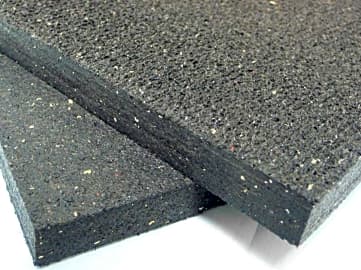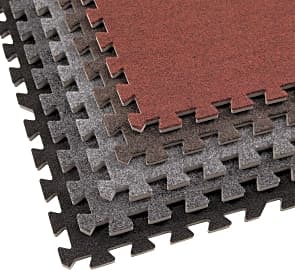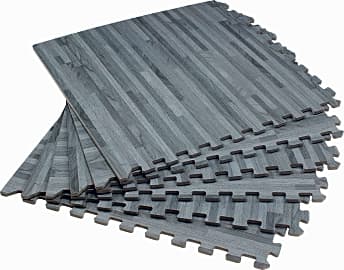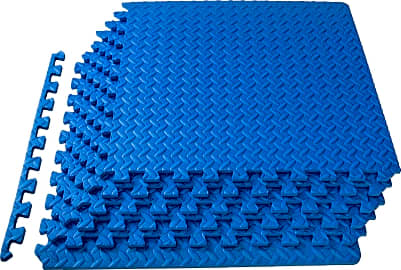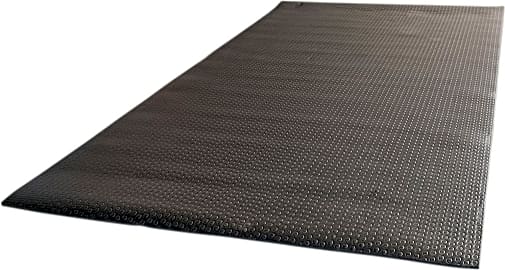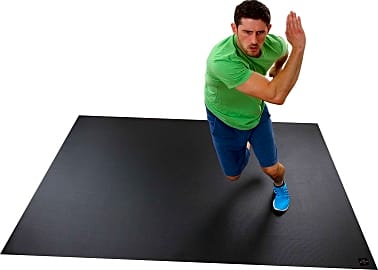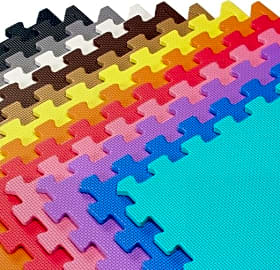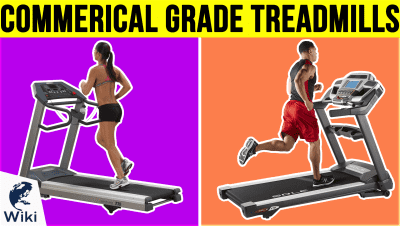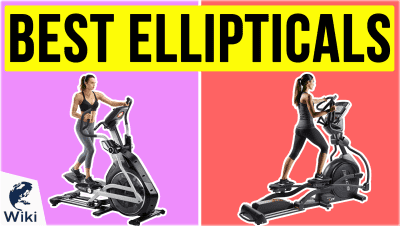The 10 Best Gym Flooring

This wiki has been updated 37 times since it was first published in December of 2016. If your family is tired of all the thumping coming from the basement, garage, or spare bedroom, try putting down some of this gym flooring. These mats can protect your floors from dropped weights and provide padding for high impact workouts. They come in interlocking and one-piece styles, and will help to minimize the noise and vibrations of treadmills and ellipticals. When users buy our independently chosen editorial picks, we may earn commissions to help fund the Wiki.
Editor's Notes
February 04, 2021:
When it comes to non-permanent gym flooring, you basically have two main types, interlocking tiles or a single-piece mat. Both can be found in foam and rubber options. Often times, people will lean towards foam models, like the BalanceFrom Puzzle Tiles, Inc Stores Eco-Soft, Forest Floor Printed, ProsourceFit Interlocking Tiles, Cap Barbell Circle Pattern and We Sell Mats Multipurpose for home use as they are lighter in weight and easier to move. They are also less likely to have an initial odor that requires some off-gassing time. Conversely, those in need of something very rugged, should look to rubber models, like the Rubber-Cal Shark Tooth and IncStores Premium Vulcanized, as these can withstand significantly more wear and tear. That being said, they are notably heavier and more cumbersome to deal with.
September 20, 2019:
When evaluating the best gym flooring we needed to consider the various kinds of gyms that users might set up. In fact, some gyms might be served best with a combination of the flooring options on this list.
For a workout space designated for cardio and floor routines like yoga or pilates, the Balance From Puzzle Tiles will provide the impact absorption and cushioning, and this option takes the tops spot for coming in a variety of thickness levels, making it one of the most versatile choices. This type of flooring will support lighter equipment such as benches.
For heavy weight machines and treadmills, floors need protection and the extra dense the Xmark Fitness Xmat can absorb the impact of a dropped deadlift. You probably won't want to cover your entire floor with this option, but it's an essential component.
Why Investing In Gym Flooring Is A Smart Idea
Unless you like having the ground look like it's come under mortar fire — then, by all means, skip the flooring.
Building a gym is an expensive proposition. You need lots of equipment, like squat racks and treadmills and mountains of weights — and now we're telling you that you need to spend money on the floor?
Yes, that's exactly what we're telling you.
If you're setting up a workout room in your home or garage, putting down flooring can protect your actual floors. Sometimes your muscles give out in the middle of a lift, or that dumbbell slips, and you'll end up dropping a weight — and, as the name suggests, weights are heavy. When they bounce, they can do a number on any type of floor, including concrete.
Don't underestimate how much people sweat during a workout, either. All that water can damage wood floors, not to mention cause a hazard if things become slippery.
Moving machines can damage the floor if you're not careful, as well. Unless you have several people capable of picking up each machine, you'll likely try to slide it a little bit — and that can scratch up your floor in a hurry.
Having proper flooring can even impact your workout. Having a flat, even surface is essential to many lifts, as you don't want to be accidentally thrown off balance in the middle of a squat. If you do body weight or Crossfit routines, you'll also want something comfy to lay down on.
Laying down proper flooring is essential before you start adding machines, and if you're worried about the cost, you should consider how expensive it might be for you if you don't lay any down.
Unless you like having the ground look like it's come under mortar fire — then, by all means, skip the flooring.
Choosing The Right Flooring For You
Now that you know you need proper flooring, the question becomes what, exactly, constitutes good gym flooring.
Luckily, you have quite a few options.
The most common is thick rubber mats or tiles. These are popular because they're durable, water-resistant, and easy to adapt to just about any space you have. They tend to be on the expensive side, though.
Many come in interlocking shapes, like jigsaw puzzle pieces, so you can buy as many or as few as you need.
Many people turn to horse stall mats, as well. These are also made of rubber, and they're also made for horses, as a way to shield their joints from hard floors. They're extremely heavy-duty, but they tend to have a strong odor and are hard to fit in any rooms that aren't perfectly square. You can cut them up and glue them back together to fit specific shapes if you like, but that's a lot of work.
If you want something more budget-friendly, foam is a smart option. Many come in interlocking shapes, like jigsaw puzzle pieces, so you can buy as many or as few as you need. They're also pretty comfortable and offer plenty of cushioning, but don't expect them to last forever.
Beyond the materials, you have a variety of design options. While black rubber is definitely utilitarian, it's not necessarily the most attractive choice. Some flooring comes in elaborate color patterns, or is made to resemble wood or tile. Of course, having pretty flooring won't help you increase your max on the bench press, but sometimes it's nice to have a break from the typical sterile gym environment.
Building The Perfect Home Gym
If you're tired of seeing those gym dues come out of your checking account every month — or you're just tired of watching that guy talk on his cell phone while he hogs the treadmill — then building a home gym is a smart alternative.
Of course, what you actually include in your gym depends a lot on your preferred workout. If you're trying to get huge, you'll need lots of weights, whereas if you're just trying to slim down, you can opt for cardio machines like ellipticals.
Putting up mirrors is something to consider as well, and not just to stroke your ego.
If money is tight, you should look for equipment that can cover a lot of ground. Squats are considered by some to be the perfect exercise, so a squat rack is one of the best places to start. Certain devices, like kettlebells, are also fantastic for total-body workouts.
After that, build it out one piece at a time, with the idea of targeting different muscle groups. This limits your up-front expenses, while also helping you customize your workout to the areas you're most interested in working on.
You can just go for an all-in-one home gym if you prefer. These fit just about everything you need in a single machine, but they tend to be massive, and you can likely get a better workout by buying all of the pieces individually.
Don't think it all has to be weights, either. You can have space set aside for yoga routines, gymnastics, or doing things like boxing.
Once you get all the gear you need, focus on ways to make your workout more tolerable, so that you're more likely to stick with it. This could mean installing TVs or stereo equipment to keep yourself entertained, or simply putting up decorations that keep you motivated (we recommend a Rocky poster).
Putting up mirrors is something to consider as well, and not just to stroke your ego. With mirrors, you can monitor your form, so that you don't hurt yourself in the middle of a lift.
With some planning and a little bit of money, you can create a workout room that rivals any you'd find in a commercial gym. You won't have to go out of your way to get there, either, saving you both time and money (in addition to the savings from cancelling your membership).
Even better, after you get everything set up, you can charge your friends to use it.



